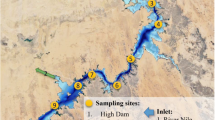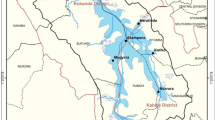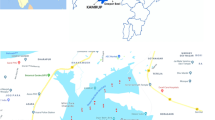Abstract
Nasser Lake is one of the world’s largest man-made lakes. It has been crucial to Egypt for several decades because of the country’s secure water supply. Underwater life (Goal 14) in Lake Nasser is under threat (e.g., due to pollution), leading in dwindling fisheries and the loss of coastal habitats. As a result, the water quality of Lake Nasser must be thoroughly researched, and changes in physico-chemical parameters in Lake Nasser water must be monitored regularly and appraised. The current state of the physico-chemical water parameters of Lake Nasser in Egypt is described in this study. The research was extremely helpful in determining the water quality situation in Lake Nasser and identifying the characteristics that need to be monitored on a regular basis. Thirteen (13) samples of water were analysed for physical and chemical properties. Kalabsha, Khour Kalabsha, Gurf Hussein, El Alaaki, El Madeek, Wadi El Arab, Ebreem, Toushka, Khour Toushka, Abu Simble, Adendan, Sara, and Arkeen were all used to gather these samples. The purpose was to find out the compatibility of properties and its utilities. The parameters were tested are Temperature, Hydrogen-ion concentration (pH), Conductivity (EC), Total Dissolved Solids (TDS), Turbidity, Nitrate, Dissolved Oxygen (DO) and Total Hardness (TH). The study showed that the temperatures of the samples are suitable environment for animal and plant aquatic life (less than 40 °C). The temperatures of the samples are suitable environment for drinking water in all water samples instead of Kalabsha and Gurf Hussin (more than 35 °C). The water is basic in all water samples. All water samples are less than the permissible limits of EC, TDS, DO and TH. Thus, water in Lake Nasser is suitable to aquatic life and fish. In relation to the percentage of turbidity, in Kalabsha, Khour Kalabsha, Gurf Hussin, El Alaaki, El Madeek, Wadi Alarab, Ebreem and Khour Toushka, turbidity is less than 5 NTU. As a result of, it is usually acceptable to consumers and the disinfection is more effective. But in Toushka, Abu Simple, Adendan, Sara and Arkeen, turbidity is more than 5 NTU. As a result of, it isn’t usually acceptable to consumers and the disinfection isn’t effective. In relation to the percentage of Nitrate, all water samples are less than 10 ppm of nitrates in drinking water and thus are safe to use.
Access this chapter
Tax calculation will be finalised at checkout
Purchases are for personal use only
Similar content being viewed by others
References
United Nations (2017) Resolution adopted by the General Assembly on 6 July 2017. Work of the Statistical Commission pertaining to the 2030 Agenda for Sustainable Development (A/RES/71/313)
Ghodeif K, Grischek T, Bartak R, Wahaab R, Herlitzius J (2016) Potential of river bank filtration (RBF) in Egypt. Environ Earth Sci 75(8)
Negm A (ed) (2017) The Nile River. The handbook of environmental chemistry
El Gamal T, Zaki N (2017) Egyptian irrigation after the Aswan high dam. In: Irrigated agriculture in Egypt, pp 47–79
Salih S, Allawi M, Yousif A et al (2019) Viability of the advanced adaptive neuro-fuzzy inference system model on reservoir evaporation process simulation: case study of Nasser Lake in Egypt. Eng Appl Comput Fluid Mech 13(1):878–891
Farhat H, Aly W (2018) Effect of site on sedimentological characteristics and metal pollution in two semi-enclosed embayments of great freshwater reservoir: Lake Nasser, Egypt. J Afr Earth Sci 141:194–206
Omran E-SE, Negm A (2018) Environmental impacts of AHD on Egypt between the last and the following 50 years. In: Grand Ethiopian renaissance dam versus Aswan high dam, pp 21–52
Omran E-SE, Negm A (2018) Environmental impacts of the GERD project on Egypt’s Aswan high dam lake and mitigation and adaptation options. In: Grand Ethiopian renaissance dam versus Aswan high dam. Springer, Cham, pp 175–196
El Shemy M (2010) Water quality modeling of large reservoirs in semiarid regions under climate change–example Lake Nasser, Egypt. Dissertation, University of Echnische
Khalifa N, El-Damhogy K, Fishar M, Nasef A, Hegab M (2015) Using Zooplankton in some environmental biotic indices to assess water quality of Lake Nasser Egypt. Int J Fisheries Aquat Stud 2(4):281–289
Chapman D (1996) Water quality assessments: a guide to use biota, sediments and water in environmental monitoring, 2nd edn. E & FN Spon, London, p 609
Omran E-SE, Selmy S, Ghallab A, Gad A-A (2012) Evaluate and map** groundwater quality using geostatistics for sustainable land management in Darb El-Arbaein, South Western Desert, Egypt. In: 21st century watershed technology: improving water quality and environment conference proceedings, May 27–June 1, 2012, Bari, Italy. American Society of Agricultural and Biological Engineers, p 1
Omran E-SE, Ghallab A, Selmy S, Gad A-A (2014) Evaluation and map** water wells suitability for irrigation using GIS in Darb El-Arbaein, South Western Desert, Egypt. Int J Water Resour Arid Environ 3(1):63–76
UNESCO UNE, Scientific and Cultural Organization (2015) International initiative on water quality: promoting scientific research, knowledge generation and dissemination and effective policies to respond to water quality challenges in a holistic and collaborative manner towards ensuring water security for sustainable development. UNESCO, Paris, France, p 26
United Nations (2016) Water and sanitation interlinkages across the 2030 agenda for sustainable development. UN-Water, Geneva, Switzerland, p 48
UNSCN (2014) Nutrition and the post-2015 sustainable development goals: a technical note. UNSCN Secretariat, Geneva, Switzerland, p 21
Vladimirova K, Le Blanc D (2016) Exploring links between education and sustainable development goals through the lens of UN flagship reports. Sustain Dev 24:254–271
UNESCO (2016) Transboundary water cooperation and the sustainable development goals. UNESCO-IHP, Paris, France, p 48
Farmer A (2017) Tackling pollution is essential for meeting SDG poverty objectives. Institute for European Environmental Policy, London, p 8
ICSU ISSC (2015) Review of targets for the sustainable development goals: the science perspective. ICSU and ISSC, Paris, France
GESAMEP (2015) Pollution in the open oceans 2009–2013. A report by a GESAMP task team. GESAMP report, United Kingdom, p 87
WHO (2011) Guidelines for drinking-water quality, 4th edn. World Health Organization. ISBN 978-92-4-154815-1. https://apps.who.int/iris/handle/10665/44584
WHO (1984) Guidelines for drinking-water quality. Recommendations World Health Organization. https://apps.who.int/iris/handle/10665/252072
Author information
Authors and Affiliations
Corresponding author
Editor information
Editors and Affiliations
Rights and permissions
Copyright information
© 2022 The Author(s), under exclusive license to Springer Nature Switzerland AG
About this chapter
Cite this chapter
Omran, ES.E., Elawah, S.A. (2022). Life Under Lake Nasser: Water Quality as Means to Achieving the Egypt’s Agenda 2030. In: Omran, ES.E., Negm, A.M. (eds) Egypt’s Strategy to Meet the Sustainable Development Goals and Agenda 2030: Researchers' Contributions. Sustainable Development Goals Series. Springer, Cham. https://doi.org/10.1007/978-3-031-10676-7_15
Download citation
DOI: https://doi.org/10.1007/978-3-031-10676-7_15
Published:
Publisher Name: Springer, Cham
Print ISBN: 978-3-031-10675-0
Online ISBN: 978-3-031-10676-7
eBook Packages: Earth and Environmental ScienceEarth and Environmental Science (R0)




